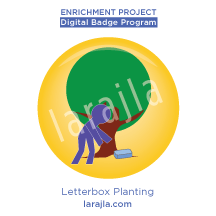 After exploring letterboxing, you may find that you want to create your own letterbox.
After exploring letterboxing, you may find that you want to create your own letterbox.
Steps
The letterbox
1. Create your own letterbox.
You’ll need a water-sealed box for your letterbox. It can be as simple as a disposable container you get at the grocery store. Inside the letterbox, you’ll need the following:
- Stamp for letterbox
- Logbook
- Pen
- Zip top bag
- Inkpad (optional)
- Letterbox explanation (optional)
2. Name your letterbox.
You want to name your letterbox. It’s more fun looking for the “Looney Cartoony Box”. You may want to name your letterbox for the location, stamp or another reason that makes sense to you. Sometimes you’ll see that letterboxes are placed and part of a series. If so, you may want to use consistency in naming your letterboxes.
3. Label your logbook.
On your letterbox logbook, write the name of the letterbox, the date it is placed and your contact information. Stamp the first page with the stamp for your letterbox. If something happens to your letterbox, your hunters can contact you.
4. Label your letterbox.
Put a label on the inside lid of your box. Include the letterbox name and your contact information in case the letterbox needs attention. If you don’t want people to have your phone number, you can include an email address. A sample of what you might put on the label:
Please do not destroy.
<Name> Letterbox
I hope you enjoy the contents of this letterbox. Please reseal and replace where found. If you’re new to letterboxing, find out more online. If the contents are damaged / missing, please contact at .
You may wish to use packing tape to help protect the paper or laminate and attach it.
5. Track your letterbox.
Before you place your letterbox, be sure you have a way to track it. This isn’t the activity that happens. That’s what the logbook is for. You want to track when you placed it, when you visited to make sure it was still there, what you needed to fix, if you relocated it as well as all the information to recreate it.
6. Place a letterbox.
Do not just place a letterbox anywhere. Some places require that you have a license to do so. Some places do not allow you to place letterboxes as it means more traffic and damage to natural areas (National Parks). Before placing a letterbox, check with your local Department of Natural Resources, other governing groups and federal/state laws about the possibility of placing your letterbox.
NOTE: Some letterboxes are placed indoors as well with a task that needs to be completed or a question answered before they gain access.
Clue it in
7. Write a clue.
Writing a clue can be fun. You may want to incorporate one or more of the following:
- Number of steps / paces
- Visual identifiers / landmarks
- Cardinal directions (north, south, east, west)
- Compass bearings
- Movement directions (right, left, forward, up, down, etc.)
- Landmarks
- Natural features (rivers, ponds, rock formations, etc.)
- Senses (sounds, smells, etc.)
- Questions
- Puzzles
- References to the area / site
8. Test your clue.
While your clue may be easy for you, it may not be for someone else. Test your clue to make sure it works before releasing it to the world.
9. Share your information.
Find a place online or locally to place your clues.
Maintenance
10. Create a kit.
As you maintain your letterbox, create a kit of items you are likely to need. This might include writing utensils, a new logbook, etc. This will save you time if you can fix it on the spot instead of returning later.
11. Check your letterbox.
Set up a schedule to check your letterbox. You’ll need to make sure the clue is still valid, the area is still accessible, all items are in good working order and more.
Supplements Available
Sites to Explore
Leave a Reply